
The Project Gutenberg EBook of The Mentor: Napoleon Bonaparte, Serial No. 38, by Ida M. Tarbell This eBook is for the use of anyone anywhere in the United States and most other parts of the world at no cost and with almost no restrictions whatsoever. You may copy it, give it away or re-use it under the terms of the Project Gutenberg License included with this eBook or online at www.gutenberg.org. If you are not located in the United States, you'll have to check the laws of the country where you are located before using this ebook. Title: The Mentor: Napoleon Bonaparte, Serial No. 38 Author: Ida M. Tarbell Release Date: August 29, 2015 [EBook #49810] Language: English Character set encoding: UTF-8 *** START OF THIS PROJECT GUTENBERG EBOOK THE MENTOR: NAPOLEON BONAPARTE *** Produced by Juliet Sutherland, Charlie Howard, and the Online Distributed Proofreading Team at http://www.pgdp.net
Transcriber’s Note
Cover created by Transcriber and placed in the Public Domain.

BY
IDA M. TARBELL
Author of “Short Life of Napoleon Bonaparte,” “He Knew Lincoln,” etc.
EMPEROR NAPOLEON · BRIDGE AT ARCOLE · FRIEDLAND—1807 · RETREAT FROM MOSCOW · ABOARD THE BELLEROPHON · ST. HELENA
Nobody who has lived in modern times has so stirred up the world as Napoleon Bonaparte. Nobody has upset so many old things, and started so many new ones. No man ever lived who had more faith in his own powers—and less respect for those of other men. Napoleon had, too, an unusual combination of those personal qualities which excite and interest men. It is nearly a hundred years since he dropped out of active life; but his story is more rather than less thrilling as time goes on.
There was nothing in his birth or schooling or his first activities in life to lead one to expect an unusual career. His family was poor and servile; his father trading on his name and his acquaintances to feed, educate, and place his family. The most promising thing about young Bonaparte was his resentment of this servility and his own flat refusal to participate in it to help himself. Throughout his boyhood in the island of Corsica, where he was born in 1769, during the six years he spent at school in France and the eight years of intermittent military service that followed his first appointment at the age of sixteen to a second lieutenancy, he lived a tempestuous inner life. Ambition for himself, devotion to his family, love for Corsica, hatred of France, sympathy for the new ideas of human rights that were stirring Europe,—these sentiments kept the mind and heart of the young officer in tumult and made him waver between allegiance to the land in which he was born and the land that had trained him; between the career of a soldier that was his passion and a career of money making, in order to educate his brothers, settle his sisters, and put his mother into a secure position.
It is quite fair, I think, to characterize his early career as that of an adventurer. He was watching for a chance, and had determined to take it, regardless of where it offered itself. It was at a moment when he was in disgrace for having refused the orders of his superiors in the army that the chance he wanted came.
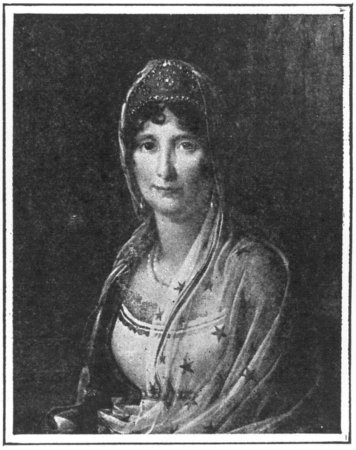
LÆTITIA BONAPARTE
The Mother of Napoleon.
The convention in which at that moment the French government centered was attacked by the revolting Parisians. Bonaparte had no particular sympathy with the convention,—in fact, he had more with the rebels,—but when one of his friends in the government who knew his ability as an artillery officer asked him to take charge of the force protecting the Tuilleries, where the convention sat, he accepted—with hesitation; but, having accepted, he did his work with a skill and daring that earned him his first important command, that of general in chief of the French Army of the Interior. Four months later he was made commander in chief of the Army of Italy, the army that was disputing the conquest of northern Italy with Austria.

WHERE AN EMPEROR WAS BORN
In this room Napoleon was born in 1769.
It was a ragged, disgusted, and half-revolting body, this Army of Italy, one that for three years had been conspicuous mainly for inactivity. Without waiting even for shoes, the new commander started it out swiftly on a campaign that for clever strategy, for rapidity of movement, for dash and courage in attack, was unlike anything Europe had ever seen. In less than two months he drove his opponents from Lombardy and had shut up the remnant of their army in Mantua. The Austrians shortly had a new army in the field. It took eight months to defeat it and capture Mantua; but it was accomplished in that period.3 Austria then called her ablest general, Archduke Charles, and gave him one hundred thousand men with which to avenge her disasters. With half the number Bonaparte advanced to meet the archduke, and drove him step by step to Vienna.
After a year and seven months of campaigning General Bonaparte, now twenty-eight years old, signed his first treaty. By that treaty he formed a new republic in northern Italy and made a new eastern frontier for France. Before the treaty, however, he had filled her empty treasury, had loaded her down with works of art, and had given her a new place in Europe; a place that he had proved he could sustain.
The glory of the Italian campaign thrilled the French people; but it disturbed the politicians in power. Bonaparte saw that if the government could manage it he would have no further opportunities for distinguishing himself. It was this sense that led him to urge that England, the only nation then in arms against France, be attacked by invading Egypt. The government consented promptly. It was a way of disposing of Bonaparte. What the government did not dream, of course, was that Bonaparte with this army hoped to found an oriental kingdom of which he should be the ruler.
But nothing went as he expected. He suffered terrible reverses, which he knew the government at home was using to break his hold on the people; his supplies and information were cut off; his prestige in his own army weakened; his faith in his destiny was shaken. That the effect of this bad fortune was not more than skin deep was clear enough when he accidentally learned that things were in a very bad way in France, that much of what he had gained in Italy had been lost, and that Austria and Russia were preparing an invasion.

BIRTHPLACE OF NAPOLEON
In this house, on the little island of Corsica, the first emperor of France spent his boyhood.
Promptly and secretly Bonaparte slipped out of Egypt, and before the powers at home knew of his intention he was in France and the people were welcoming him as their deliverer. He was ready to be just that. It was no great trick for a man of his daring and sagacity, adored by the populace, to overturn a discredited and inefficient government and make himself dictator. It was done in a few weeks, and France had a new form of government, a consulate, of which the head was a first consul, and Bonaparte was the first consul.
The most brilliant and fruitful four years of Napoleon Bonaparte’s life followed; for it was then that he set out to bring order and peace to a country demoralized and exhausted by generations of plundering by privileged classes, followed by a decade of revolution against privileges. France needed new machinery of all kinds, and this Bonaparte undertook to supply. There were many people who regarded him as a great general; but to their amazement he now proved himself a remarkable statesman.
He attacked the question of the national income like a veteran financier. The first matter was reorganizing taxation. He succeeded in distributing the burden more justly than had ever been known in France. The taxes were fixed so that each knew what he had to pay, and the inordinate graft that tax collectors and police had enjoyed was cut off. New financial institutions were devised; among them the Bank of France. The economy he instituted in the government, the army, his own household, everywhere that his power extended, was rigid and minute; as he personally examined all accounts, there was no escape. The waste and parasitism that pervaded the country began to give way for the first time since the Revolution.

EMPRESS JOSEPHINE
From a painting by Pierre Paul Prud’hon.
Industries of all kinds had sickened in the long period of war. Bonaparte undertook their revival by one of the most severe applications ever made of the doctrine of protection,—he even attempted to make his women folk wear no goods not made in France! His interest in agriculture was as keen as in manufacturing, and his personal suggestions and interference of the same nature. The prosperity of the country was stimulated greatly by the public works Bonaparte undertook. One can go nowhere in France today without finding them. It was he who set the country at road building. Some of the most magnificent highways in Europe were laid out by him, including those over four Alpine passes. He paid great attention to improving harbors. Those now at Cherbourg, Havre, and Nice, as well as at Flushing and Antwerp, Bonaparte planned and began. As for Paris, his ambition for the city was boundless. He was responsible for some of her finest features and monuments.
His greatest civil achievement was undoubtedly the codification of the laws, and it was the one of which he was proudest. That he contributed much to the Code Napoleon besides the driving power that insisted that it be promptly put through, there is no doubt. His great contribution was the inestimable one of commonsense. He had no patience with meaningless precedents, conventions, and technicalities. He wanted laws that everybody could understand and would recognize as necessary and just.
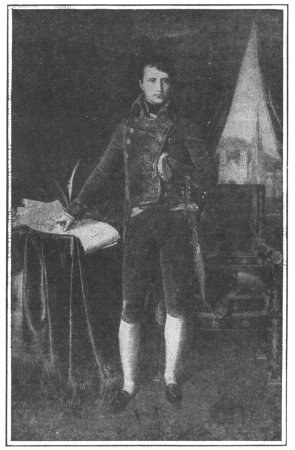
Nothing more daring was undertaken in this period by Bonaparte than his reëstablishment of the Catholic Church and his recall of thousands of members of the old régime driven out of the country by the Revolution. It was an attempt to reconcile and restore the two most powerful6 enemies of the Revolution, the two that the first consul knew Europe would never cease to fight to restore to power. There was of course great opposition in radical and republican circles to both ventures.

NAPOLEON BONAPARTE
From the painting by Delaroche.
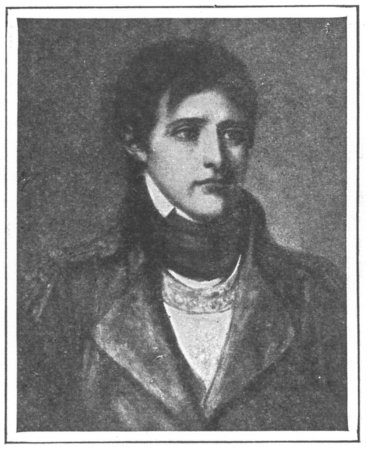
LIEUTENANT OF ARTILLERY
From a painting of Napoleon by Greuse.
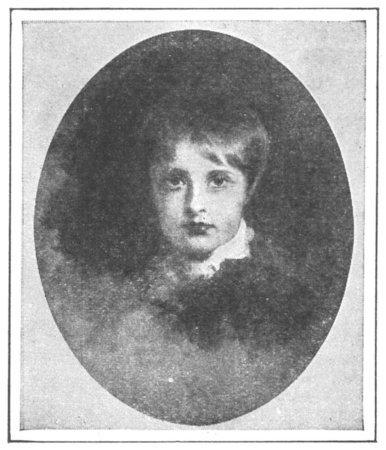
KING OF ROME
From a painting by Sir Thomas Lawrence of the unfortunate little son of Napoleon and Marie Louise. His unhappy story is told by the French dramatist Rostand, in the play “L’Aiglon.”
What Napoleon aimed at was to fit together all the different elements that had made France, under a government that he should direct, and then to impose upon them all peace, industry, and loyalty. Considering the character and history of the elements he was working with, the degree of his success is one of the wonders of statecraft. As time went on, however, he was subjected to more and more jealousy, criticism, and intrigue. And as he saw his power questioned his grasp tightened. He even began to employ the tactics of despots,—espionage, censorships, summary punishments. The upshot of the attacks upon him and of his determination to impose his own will was that in 1804, when he was thirty-five years old, he had himself made emperor of the French. I think there is no doubt that Napoleon believed that this was the only method by which he could make the position of France in Europe impregnable; but that he was willing to play the emperor there is no doubt. The dream of a throne where he should rule—for the welfare and happiness of7 everybody concerned, no doubt, but rule—brilliantly and absolutely—had never left his mind since boyhood—and now it was a fact accomplished!
The spectacle that followed is almost unbelievable. Napoleon with perfect seriousness set about to train himself, his lovable, but vain and unprincipled empress, Josephine, his selfish and vulgar family, his train of rough intimates of the battlefield, to the etiquette, ceremonies, and dignity of a court. He worked with the same energy, attention to details, and with the same insistence on complete obedience as when directing a campaign. The Napoleonic court achieved real brilliance and dignity; but to those born to the purple it was always an upstart’s court. That it was far and away more moral, economic, and orderly, as well as more serviceable to France, counted for little with those of the old régime.
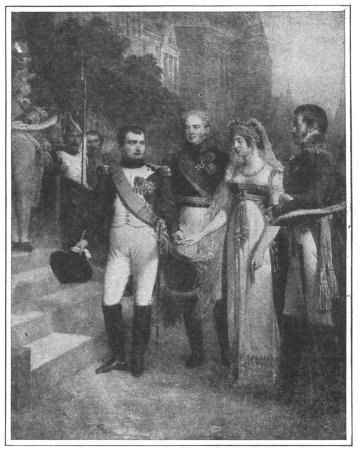
The year after Napoleon was crowned emperor of the French (1804) he had himself crowned king of Italy. The territory he now governed included not only these two countries, but several Germanic states. It was an enormous power, and the old kingdoms of Europe, England, Austria, and Russia looked on in dismay. It was not only his power, backed as it was by his genius, but it was the ideas he was spreading. Everywhere he went he put his new code of laws into force, and preached, even if he did not always practise, personal liberty, equality before the law, religious tolerance,—ideas that many of his enemies feared more than they did armies.
A coalition against him was inevitable, and in 1805 he took the field again. The campaigns that followed closely in the next four years include some of his most interesting military feats,—the battle of Austerlitz, of which he was proudest himself; the campaign of Jena, by which he humbled Prussia, increased French territory largely, and won the czar of Russia as an ally; the war on Spain, which ended in his own deserved defeat (Napoleon at St. Helena characterized his attack on Spain as “unjust,” “cynical,” “villainous”); the campaign of Wagram, which finally humbled his persistent enemy Austria.
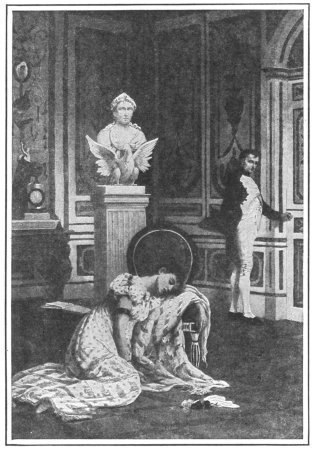
NAPOLEON’S FAREWELL TO JOSEPHINE
For reasons of state Napoleon divorced the Empress Josephine to marry Marie Louise, the daughter of the emperor of Austria. His last words to the woman who loved him were: “My destiny and France demand it!”
At the end of these four years Napoleon was himself the practical master of Europe; the only nation not recognizing his power being England, which was at least temporarily quiet. He had created an empire; but what was he to do with it? He had no heir. To provide for one he carried out a plan long considered,—he divorced Empress Josephine and married again. The new empress was the daughter of the old and now humbled enemy of France, the emperor of Austria. Napoleon apparently believed that on the birth of an heir France would accept him fully, and that Europe would cease to fear and resent his power. He was wrong. He had stripped too many of wealth and position, outraged too many social and religious conventions, set in motion too many ideas hostile to those that Europe as a whole lived by. His demands on subjects10 and allies were too heavy, and particularly the one that he had most at heart,—that no continental nation should allow a dollar’s worth of England’s goods to cross its borders. His punishment of those who displeased him and disobeyed his orders was too severe. A revolt against his monstrous assumption was inevitable.

NAPOLEON BONAPARTE
From a portrait of the Emperor painted by Paul Delaroche.
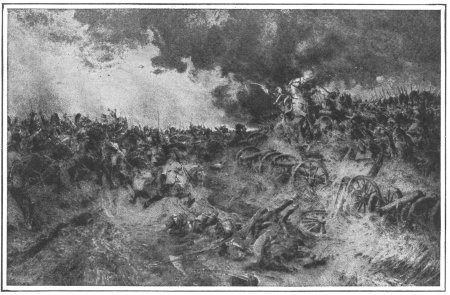
It was with his ally, Russia, that the first break came. That Napoleon was startled by the idea of war with Alexander and sought to prevent it, is certain; but Alexander refused to yield to his demand that the embargo against English goods be enforced. The embargo he had set down as the “fundamental law of the Empire.” There was nothing to do but settle it by arms, and in the summer of 1812, with an army of over half a million men, he began a reluctant and hesitating march against Russia. It was a campaign of terrible disasters. The Russians retreated before him, letting cold and hunger do the work of battles. So effectively did they work that the French army was practically destroyed. The Russian campaign is one of the most appalling in history. It was but the beginning of his overthrow. Alexander raised the cry “Deliver Europe!” Stein and other liberal minds rallied the youth of the11 German states into a league, pledged to fight for national freedom. His allies and dependences began to demand the return of lost territories as a price of loyalty. France revolted at the prospects of continued bloodshed. The campaigns thrust upon him by all these forces were fought; but frequently without his old genius.
It was June of 1812 when Napoleon began the Russian campaign. Twenty-one months later Paris capitulated to his allied enemies, and a few weeks later he had lost the greatest empire modern Europe had seen gathered under one man, and was an exile in the little island of Elba.
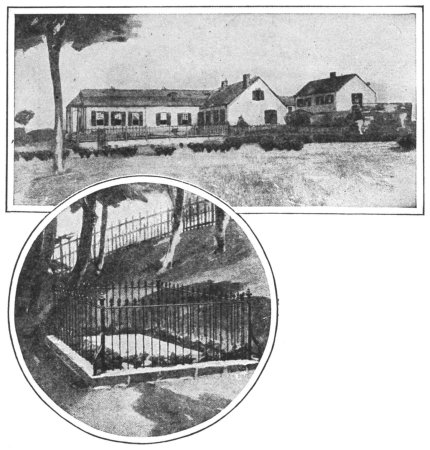
LONGWOOD
Napoleon’s residence during his captivity at St. Helena.
AN EXILE’S GRAVE
The spot where Napoleon was buried in May, 1821. His body was removed to Paris in 1840.
His dramatic escape from Elba; the scurry out of France at news of his arrival of all who had opposed him, leaving the coast practically clear for him; the rally of the army and people to him; the immediate attack upon him by the allied powers of Europe; his defeat at Waterloo and speedy exile to St. Helena,—these make perhaps the most dramatic succession of events in all history, and it was not he who lost by the record of them, though it ended in his captivity. Napoleon a prisoner on an island six hundred miles from land was Napoleon still. He was there because of his conquerors’ fear of him. No greater tribute to one man’s power was ever paid than that of Europe when under English leadership she consented to confine Napoleon Bonaparte on the island of St. Helena. It was all that was needed to impress him forever on the world as one of heroic mold.
SUPPLEMENTARY READING.—“Short Life of Napoleon Bonaparte,” Ida M. Tarbell; “The First Napoleon,” John C. Ropes; “Napoleon Bonaparte, First Campaign,” H. H. Sargent; “Life of Napoleon,” Las Casas; “Napoleon, the Last Phase,” Lord Rosebery; “Letters and Papers of Napoleon”; “Napoleana,” Frédéric Masson.
ISSUED SEMI-MONTHLY BY
The Mentor Association, Inc.
381 Fourth Ave., New York, N. Y.
Vol. 1 No. 38
ANNUAL SUBSCRIPTION, FOUR DOLLARS. SINGLE COPIES TWENTY CENTS. FOREIGN POSTAGE, SEVENTY-FIVE CENTS EXTRA. CANADIAN POSTAGE, FIFTY CENTS EXTRA. ENTERED AT THE POST OFFICE AT NEW YORK, N. Y., AS SECOND-CLASS MATTER.
For some time past we have felt that the cover of The Mentor has been of rather a “severe and formal” cut, and that it would be well for us to adopt a design that was composed of lines that were somewhat more gracious and flowing.
We have chosen this cover after a number of experiments. It has not been an easy matter to settle. The Mentor, as we have stated more than once, is not simply a magazine. It does not call for the usual magazine cover treatment. What we have always wanted and have always sought for from the beginning has been a cover that would express, in the features of its design, the quality of the publication. In the endeavor to make clear by dignified design the educational value and importance of The Mentor, the tendency would be to lead on to academic severity—and that we desire least of all. On the other hand, it would be manifestly inappropriate to wear a coat of many colors. The position of The Mentor in the field of publication is peculiar—its interest unique. How best could its character be expressed in decorative design?
We believe that Mr. Edwards has given us in the present cover a fitting expression of the character of The Mentor. It is unusual in its lines—that is, for a periodical. It has the quality of a fine book cover design—at least so we think. It will, we believe, invite readers of taste and intelligence to look inside The Mentor, and as experience has taught us, an introduction to The Mentor usually leads on to continued acquaintance.
We want The Mentor to be regarded as a companion. It has often been said that books are friends. We give you in The Mentor the good things out of many books, and in a form that is easy to read and that taxes you little for time. A library is a valuable thing to have—if you know how to use it. But there are not many people who know how to use a library. If you are one of those who don’t know, it would certainly be worth your while to have a friend who could take from a large library just what you want to know and give it to you in a pleasant way. The Mentor can be such a friend to you.
And since the word “library” has been used, let us follow that just a bit further. The Mentor may well become yourself in library form. Does that statement seem odd? Then let us put it this way: The Mentor is a cumulative library for you, each day, each week—a library that grows and develops as you grow and develop—a library that has in it just the things that you want to know and ought to know—and nothing else. Day by day and week by week you add with each number of The Mentor something to your mental growth. You add it as you add to your stature—by healthy development; and the knowledge that you acquire in this natural, agreeable way becomes a permanent possession. You gather weekly what you want to know, and you have it in an attractive, convenient form. It becomes thus, in every sense, your library, containing the varied things that you know. And you have its information and its beautiful pictures always ready to hand to refer to and to refresh your mind.
So in time your assembled numbers of The Mentor will represent in printed and pictorial form the fullness of your own knowledge.
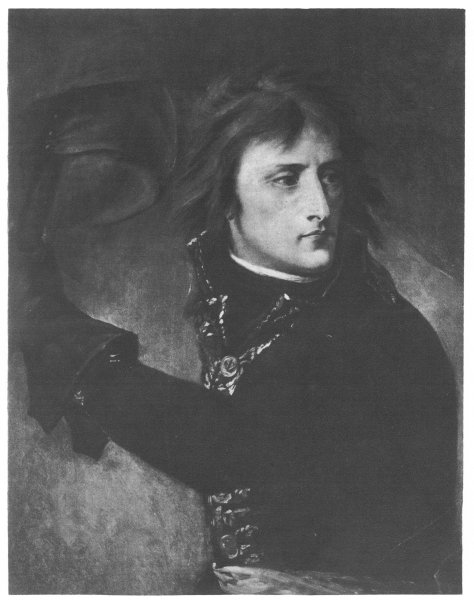
NAPOLEON AT ARCOLE, from the painting by Antoine Jean Gros, is the subject of one of the intaglio-gravure pictures illustrating “Napoleon Bonaparte.”
“Follow your general!” was the cry with which young Bonaparte urged his army to victory at Arcole. He was only twenty-seven years old at the time—and yet was commander in chief of the army of Italy. The years that brought Napoleon into prominence had been troublous ones. He was born in Corsica, and in moderate circumstances. The exact date of his birth is uncertain. At school he said it was 1768. It is stated that he gave this date because that made him a citizen of Genoa, inasmuch as Corsica was at that time a dependency of Genoa. Later on he said that he was born in 1769; for Corsica had then become a French possession, and this made him a Frenchman by birth. After early schooling at Brienne young Napoleon entered the military academy of Paris in 1784. After a year he was commissioned as a sublieutenant in the regular army, and made rapid progress from the start. As lieutenant colonel he distinguished himself in the wars of Spain. He held the mobs boldly and in masterful manner during the turbulent scenes in the early days of the Revolution. Barras, a high official, recognized his military genius and gave Bonaparte command of the army of Italy.
The capture of the bridge at Arcole was essential to the success of the Italian campaign. For three days the Austrian army gallantly opposed the attacks of Napoleon’s forces, and it was only by the personal courage of the young general that victory was finally won. Bonaparte personally led a rush across the bridge at Arcole, and he was the real vital force in the battle. He saw his staff killed or wounded about him during the onslaughts. Once he himself was swept by a counter attack of the Austrian forces into a swamp, where he nearly perished.
Napoleon’s army consisted of 18,000 men, which he had moved over the narrow and rugged roads with heavy baggage at a rate of fourteen miles a day for three consecutive days,—the same rate at which Stonewall Jackson made his marches through the Shenandoah Valley. It was a remarkable achievement under the conditions Napoleon had to face.
And with this force he met an Austrian army of 40,000 and defeated it signally after a bitter engagement.
COPYRIGHT, 1913, BY THE MENTOR ASSOCIATION, INC.
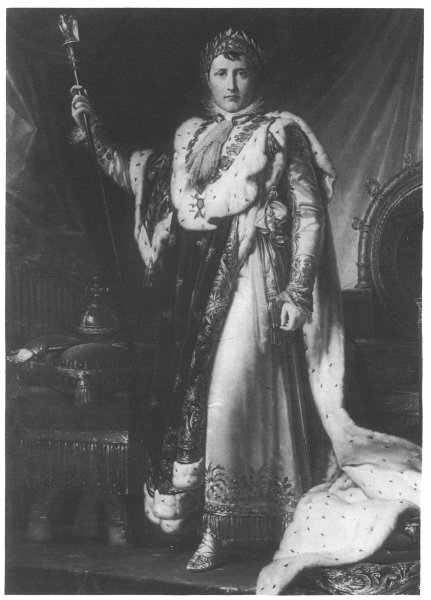
EMPEROR NAPOLEON, from the painting by François Gérard, is the subject of one of the intaglio-gravure pictures illustrating “Napoleon Bonaparte.”
“I shall now give myself to the administration of France.” That was the statement of Napoleon Bonaparte in 1802 after he had overthrown the government and had instituted a consulate, to which he was elected first for ten years, and then for life. There were three consuls, and Napoleon was known as the first consul. To one of his sublime ambition, however, the thought of association in government was unbearable. Two years later, despite his attitude expressed in his own words, “I am a friend of the Republic; I am a son of the Revolution; I stand for the principles of liberty, equality, and fraternity,” Napoleon determined to make an office for himself that would be absolute and hereditary. The title of king had grown hateful to the people of France; so Napoleon chose “emperor” instead, and in 1804 he assumed the title and the office.
Many were shocked; but none could resist his assumption of imperial power. A popular vote showed that only 2,500 people opposed the new government. Pope Pius VII accepted Napoleon’s request to take part in the coronation ceremony on December 2, 1804. The event occurred at Notre Dame Cathedral. The pope poured the mystic oil on the head of the kneeling sovereign. It was ten centuries since any pope had left Rome for a coronation, and in the minds of the Latin peoples this was a consecration of a monarch that put him on an equal plane with the proudest rulers of Europe, whose power reposed on the basis of Divine Right. When the pope lifted the crown Napoleon performed an act so striking in its originality that the people held their breath. He took the crown from the pope’s hands and placed it on his own head. He then crowned Empress Josephine.
A few months later Napoleon journeyed to Milan, the capital of what was called the Cisalpine Republic, and there proclaimed the kingdom of Italy. He crowned himself then with “the iron crown of the Lombards” and named Prince Eugène, his stepson, heir to the throne.
During the ceremonies the republic of Genoa sent ambassadors to Paris with the request to be incorporated into the French empire. This offended Austria, and led to the third war with that empire since 1792, when the republic of France was proclaimed.
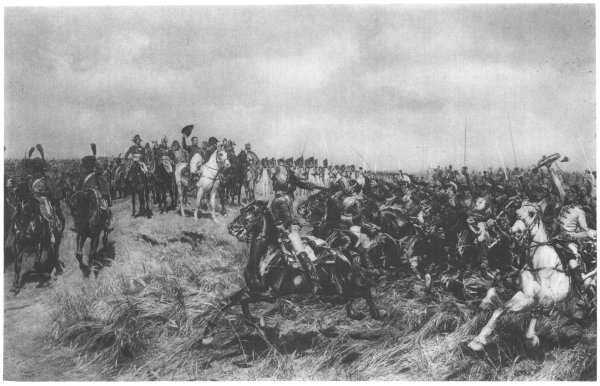
FRIEDLAND—“1807,” from the painting by Meissonier, is the subject of one of the intaglio-gravure pictures illustrating “Napoleon Bonaparte.”
Emperor Napoleon’s brilliant victory at Friedland was the event that placed him at the topmost height of his military power. In a fierce battle, noted for the strategy characteristic of Bonaparte, he defeated a large Russian army. This was on June 14, 1807.
Czar Alexander of Russia had refused to comply with the demands of Napoleon regarding trade with England. England would not recognize Napoleon as emperor, and he retorted by forcing several of the European nations to sever commercial connections with England. Czar Alexander held out. The forces of both emperors met at a small town called Heilsberg, near Friedland. Napoleon disposed his army in such a way that he led the Russian general, Bennigsen, to believe that he had to conquer only a small number at Friedland. Part of the French army was hidden in the semi-circle of wooded hills that surrounded Friedland.
From one of these hills Napoleon watched the movement of Bennigsen and his army of 30,000. The Russian general believed that a corps of 1,500 men in command at Lannes, stationed at Friedland, was the extent of the forces opposing him. Bennigsen engaged in a skirmish with this corps, and drove it back into the city. The Russian army then followed, and crossed the River Albe. Napoleon waited, feeling assured that Bennigsen would not have time to retreat. Then he brought his army of 60,000 men to the aid of Lannes, and surrounded the Russians, pouring upon them a converging fire which worked disastrous results. The fragments of Bennigsen’s army retreated to the Russian border, whither Napoleon’s forces pursued them.
At the Russian frontier Napoleon received a communication from Czar Alexander requesting peace. It was agreed that the two emperors should meet on a floating raft near the city of Tilsit.
The result of this conference was the foundation of what has been called “Napoleon’s dream to build a vast European empire.”
Whatever may be said of that, it was surely the beginning of his downfall.
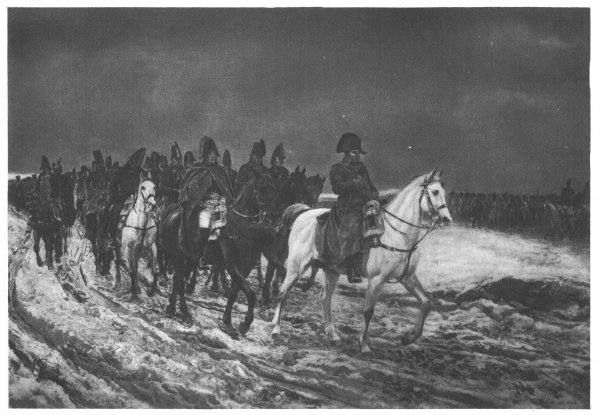
RETREAT FROM MOSCOW, from the painting by Meissonier, is the subject of one of the intaglio-gravure pictures illustrating “Napoleon Bonaparte.”
Napoleon’s invasion of Russia was one of the most disastrous military enterprises in the history of the world. It was not the Russians that defeated the emperor. During much of his advance he was left alone. Sometimes he was harrassed by skirmish forces. Several great battles were fought, notably that of Borodino. But for the most part he was allowed to go on his way; for his enemies knew that he had greater than human forces to face and battle with,—the vast Russian solitudes and the cruel, killing Russian winter. The terrible story is summed up in the statement that Napoleon invaded Russia with an armed force numbering more than 500,000 men, and that he returned with less than 30,000.
Bonaparte had once said, “I will never lead an army to destruction as did Charles XII on the steppes of Russia. My soldiers are my children.” However, when Czar Alexander of Russia refused to accept his terms, Napoleon assembled his grand army of Frenchmen, Italians, Austrians, and Germans and invaded Russia as far as Moscow, a distance of 2,000 miles from Paris.
He was victorious at Moscow; but the Russians burned the city, and thus destroyed it for purposes of winter quarters. The czar delayed in his negotiations for peace so long that Napoleon was compelled to order a retreat, which began on October 19, 1812. His army was then harassed from the rear, and many lives were lost in these engagements. After two weeks of marching the soldiers met the first wave of Russian winter. The roads were frozen sheets of ice, and in a week nearly all the horses perished. The cavalry could no longer ward off the attacks of Cossacks. Many of the guns had to be abandoned. The army lacked the artillery necessary to fight a big battle. Food supplies had to be abandoned, as there were no horses to draw them. Thousands stretched out by the fire at night never to awaken in the morning. Cold and starvation killed them.
At Smolensk the army presented an appalling spectacle. Napoleon headed it, clad in furs, his expression set and stern. Behind him came the captains, majors, and lieutenants, then a few harnessed wagons with the emperor’s war chest and papers; after that the straggling forces, many of them unarmed, limping, half frozen, some wandering away with wild looks, others falling by the roadside never to rise again.
At the frontier Napoleon left this pitiful fragment of an army in charge of the king of Naples, took a horse, and rode to Paris.
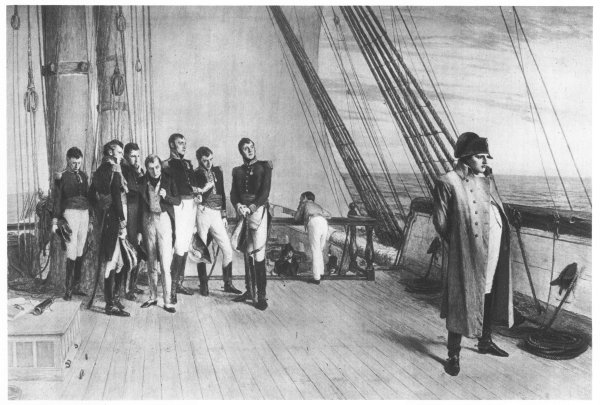
NAPOLEON ON BOARD THE BELLEROPHON, from the painting by W. Q. Orchardson, is the subject of one of the intaglio-gravure pictures illustrating “Napoleon Bonaparte.”
The Battle of Waterloo, June 18, 1815, was the final blow to Napoleon’s power. On that day hung the fate of Europe. Napoleon faced the allied forces of Prussia, England, Germany, and the Dutch, and had assembled an army of 70,000 to meet them. The allied forces were under command of the Duke of Wellington. They were bound together by one stern purpose,—to annihilate once for all the man whom they called the scourge of Europe. A heavy rainstorm prevented the emperor from carrying out his original plan of attack, which was to meet the enemy in two sections. The night of June 17 was stormy. A heavy rainstorm made the roads so heavy that the emperor could not move his cannon into the place desired until a short time before the enemy’s forces joined. Then, too, General Grouchy had been instructed to intercept the Prussian forces under Blücher, and hold them back while Napoleon fought his fight with Wellington. If he could not do that, he was at least to follow Blücher to Waterloo. The arrival, therefore, of Blücher and his forces in good fighting trim put the French into such confusion that a crushing defeat was inevitable. In the rout men had to save themselves as best they could.
Napoleon left the field, and took the road to Paris, where he found his power gone. He resigned as emperor in favor of his son, and went to Rochefort in hope of finding a ship going to the United States. The English vessel Bellerophon blockaded the harbor, and Napoleon boarded it, throwing himself on the mercy of Great Britain. He reckoned, however, without his host; for England had never forgotten that Napoleon had threatened an invasion of Great Britain. Moreover, within the year Napoleon had been declared an international outlaw, “outside the pale of social and civil relations, and liable to public vengeance.”
So, as Napoleon crossed the English Channel from Rochefort to Portsmouth, with Captain Maitland, on board his Majesty’s ship Bellerophon, he had sought safety in the lion’s mouth. England assumed charge of him on behalf of all Napoleon’s European enemies, and consigned him to exile on the island of St. Helena.
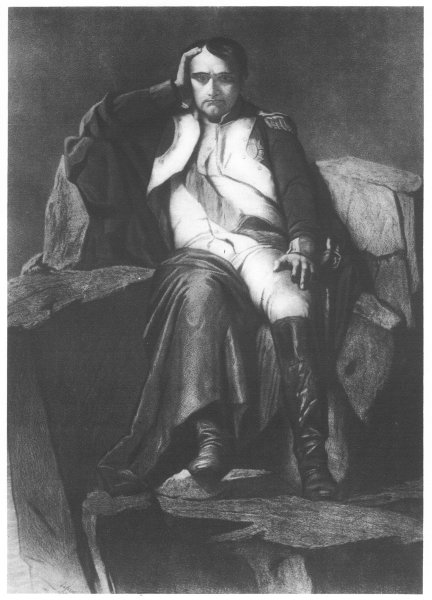
NAPOLEON AT ST. HELENA, from the painting by Paul Belaroche, is the subject of one of the intaglio-gravure pictures illustrating “Napoleon Bonaparte.”
On a rock-bound island in the South Atlantic the greatest military genius of all time spent the last six years of his life. There Napoleon dragged out the months in company with a number of his former associates, recalling the glories of the past and complaining of the bitter conditions of the present. There he wrote interesting memorial papers and gave expression to the ripe results of his military training.
Sir Hudson Lowe, a British military officer with little tact or diplomacy, was his jailer. It was not possible for such a man and Napoleon Bonaparte to meet on terms of amity. Writers on the subject differ, as they do on almost all the episodes of Napoleon’s life. Some say that Sir Hudson abused and insulted Napoleon shamefully. However, there are French writers who try to prove that Napoleon continually lied to and intrigued against the governor.
Napoleon’s mind during these days turned frequently toward his son, “the little king of Italy,” and he dictated many instructions as to the boy’s future. It might have been with the hope that at some future time an empire might come to his son that he also dictated those elaborate memoirs in which he gave an account of himself.
During a terrific storm of wind and rain on the night of May 5, 1821, Napoleon died. The dash of the waves and the roar of the storm seemed to stir his fading faculties and to arouse in him a memory of the din of battle; for his last words were “Tête d’armée” (the head of the army), and with that ejaculation in a sharp military tone his lips closed forever.
He was buried near his favorite haunt,—a fountain shaded by weeping willows, at Longwood, the estate on which he had lived at St. Helena. British soldiers accompanied his body to rest with reversed arms and fired a parting salute over his grave.
In his will the following extraordinary statement appeared: “My wish is to be buried on the banks of the Seine, in the midst of the French people, whom I so dearly loved.”
In 1840 his body was ceremoniously transferred to Paris and buried in the Hôtel des Invalides with every circumstance of military pomp and national mourning.
Simple typographical errors were corrected; punctuation, hyphenation, and spelling were made consistent when a predominant preference was found in this book; otherwise they were not changed.
End of the Project Gutenberg EBook of The Mentor: Napoleon Bonaparte, Serial
No. 38, by Ida M. Tarbell
*** END OF THIS PROJECT GUTENBERG EBOOK THE MENTOR: NAPOLEON BONAPARTE ***
***** This file should be named 49810-h.htm or 49810-h.zip *****
This and all associated files of various formats will be found in:
http://www.gutenberg.org/4/9/8/1/49810/
Produced by Juliet Sutherland, Charlie Howard, and the
Online Distributed Proofreading Team at http://www.pgdp.net
Updated editions will replace the previous one--the old editions will
be renamed.
Creating the works from print editions not protected by U.S. copyright
law means that no one owns a United States copyright in these works,
so the Foundation (and you!) can copy and distribute it in the United
States without permission and without paying copyright
royalties. Special rules, set forth in the General Terms of Use part
of this license, apply to copying and distributing Project
Gutenberg-tm electronic works to protect the PROJECT GUTENBERG-tm
concept and trademark. Project Gutenberg is a registered trademark,
and may not be used if you charge for the eBooks, unless you receive
specific permission. If you do not charge anything for copies of this
eBook, complying with the rules is very easy. You may use this eBook
for nearly any purpose such as creation of derivative works, reports,
performances and research. They may be modified and printed and given
away--you may do practically ANYTHING in the United States with eBooks
not protected by U.S. copyright law. Redistribution is subject to the
trademark license, especially commercial redistribution.
START: FULL LICENSE
THE FULL PROJECT GUTENBERG LICENSE
PLEASE READ THIS BEFORE YOU DISTRIBUTE OR USE THIS WORK
To protect the Project Gutenberg-tm mission of promoting the free
distribution of electronic works, by using or distributing this work
(or any other work associated in any way with the phrase "Project
Gutenberg"), you agree to comply with all the terms of the Full
Project Gutenberg-tm License available with this file or online at
www.gutenberg.org/license.
Section 1. General Terms of Use and Redistributing Project
Gutenberg-tm electronic works
1.A. By reading or using any part of this Project Gutenberg-tm
electronic work, you indicate that you have read, understand, agree to
and accept all the terms of this license and intellectual property
(trademark/copyright) agreement. If you do not agree to abide by all
the terms of this agreement, you must cease using and return or
destroy all copies of Project Gutenberg-tm electronic works in your
possession. If you paid a fee for obtaining a copy of or access to a
Project Gutenberg-tm electronic work and you do not agree to be bound
by the terms of this agreement, you may obtain a refund from the
person or entity to whom you paid the fee as set forth in paragraph
1.E.8.
1.B. "Project Gutenberg" is a registered trademark. It may only be
used on or associated in any way with an electronic work by people who
agree to be bound by the terms of this agreement. There are a few
things that you can do with most Project Gutenberg-tm electronic works
even without complying with the full terms of this agreement. See
paragraph 1.C below. There are a lot of things you can do with Project
Gutenberg-tm electronic works if you follow the terms of this
agreement and help preserve free future access to Project Gutenberg-tm
electronic works. See paragraph 1.E below.
1.C. The Project Gutenberg Literary Archive Foundation ("the
Foundation" or PGLAF), owns a compilation copyright in the collection
of Project Gutenberg-tm electronic works. Nearly all the individual
works in the collection are in the public domain in the United
States. If an individual work is unprotected by copyright law in the
United States and you are located in the United States, we do not
claim a right to prevent you from copying, distributing, performing,
displaying or creating derivative works based on the work as long as
all references to Project Gutenberg are removed. Of course, we hope
that you will support the Project Gutenberg-tm mission of promoting
free access to electronic works by freely sharing Project Gutenberg-tm
works in compliance with the terms of this agreement for keeping the
Project Gutenberg-tm name associated with the work. You can easily
comply with the terms of this agreement by keeping this work in the
same format with its attached full Project Gutenberg-tm License when
you share it without charge with others.
1.D. The copyright laws of the place where you are located also govern
what you can do with this work. Copyright laws in most countries are
in a constant state of change. If you are outside the United States,
check the laws of your country in addition to the terms of this
agreement before downloading, copying, displaying, performing,
distributing or creating derivative works based on this work or any
other Project Gutenberg-tm work. The Foundation makes no
representations concerning the copyright status of any work in any
country outside the United States.
1.E. Unless you have removed all references to Project Gutenberg:
1.E.1. The following sentence, with active links to, or other
immediate access to, the full Project Gutenberg-tm License must appear
prominently whenever any copy of a Project Gutenberg-tm work (any work
on which the phrase "Project Gutenberg" appears, or with which the
phrase "Project Gutenberg" is associated) is accessed, displayed,
performed, viewed, copied or distributed:
This eBook is for the use of anyone anywhere in the United States and
most other parts of the world at no cost and with almost no
restrictions whatsoever. You may copy it, give it away or re-use it
under the terms of the Project Gutenberg License included with this
eBook or online at www.gutenberg.org. If you are not located in the
United States, you'll have to check the laws of the country where you
are located before using this ebook.
1.E.2. If an individual Project Gutenberg-tm electronic work is
derived from texts not protected by U.S. copyright law (does not
contain a notice indicating that it is posted with permission of the
copyright holder), the work can be copied and distributed to anyone in
the United States without paying any fees or charges. If you are
redistributing or providing access to a work with the phrase "Project
Gutenberg" associated with or appearing on the work, you must comply
either with the requirements of paragraphs 1.E.1 through 1.E.7 or
obtain permission for the use of the work and the Project Gutenberg-tm
trademark as set forth in paragraphs 1.E.8 or 1.E.9.
1.E.3. If an individual Project Gutenberg-tm electronic work is posted
with the permission of the copyright holder, your use and distribution
must comply with both paragraphs 1.E.1 through 1.E.7 and any
additional terms imposed by the copyright holder. Additional terms
will be linked to the Project Gutenberg-tm License for all works
posted with the permission of the copyright holder found at the
beginning of this work.
1.E.4. Do not unlink or detach or remove the full Project Gutenberg-tm
License terms from this work, or any files containing a part of this
work or any other work associated with Project Gutenberg-tm.
1.E.5. Do not copy, display, perform, distribute or redistribute this
electronic work, or any part of this electronic work, without
prominently displaying the sentence set forth in paragraph 1.E.1 with
active links or immediate access to the full terms of the Project
Gutenberg-tm License.
1.E.6. You may convert to and distribute this work in any binary,
compressed, marked up, nonproprietary or proprietary form, including
any word processing or hypertext form. However, if you provide access
to or distribute copies of a Project Gutenberg-tm work in a format
other than "Plain Vanilla ASCII" or other format used in the official
version posted on the official Project Gutenberg-tm web site
(www.gutenberg.org), you must, at no additional cost, fee or expense
to the user, provide a copy, a means of exporting a copy, or a means
of obtaining a copy upon request, of the work in its original "Plain
Vanilla ASCII" or other form. Any alternate format must include the
full Project Gutenberg-tm License as specified in paragraph 1.E.1.
1.E.7. Do not charge a fee for access to, viewing, displaying,
performing, copying or distributing any Project Gutenberg-tm works
unless you comply with paragraph 1.E.8 or 1.E.9.
1.E.8. You may charge a reasonable fee for copies of or providing
access to or distributing Project Gutenberg-tm electronic works
provided that
* You pay a royalty fee of 20% of the gross profits you derive from
the use of Project Gutenberg-tm works calculated using the method
you already use to calculate your applicable taxes. The fee is owed
to the owner of the Project Gutenberg-tm trademark, but he has
agreed to donate royalties under this paragraph to the Project
Gutenberg Literary Archive Foundation. Royalty payments must be paid
within 60 days following each date on which you prepare (or are
legally required to prepare) your periodic tax returns. Royalty
payments should be clearly marked as such and sent to the Project
Gutenberg Literary Archive Foundation at the address specified in
Section 4, "Information about donations to the Project Gutenberg
Literary Archive Foundation."
* You provide a full refund of any money paid by a user who notifies
you in writing (or by e-mail) within 30 days of receipt that s/he
does not agree to the terms of the full Project Gutenberg-tm
License. You must require such a user to return or destroy all
copies of the works possessed in a physical medium and discontinue
all use of and all access to other copies of Project Gutenberg-tm
works.
* You provide, in accordance with paragraph 1.F.3, a full refund of
any money paid for a work or a replacement copy, if a defect in the
electronic work is discovered and reported to you within 90 days of
receipt of the work.
* You comply with all other terms of this agreement for free
distribution of Project Gutenberg-tm works.
1.E.9. If you wish to charge a fee or distribute a Project
Gutenberg-tm electronic work or group of works on different terms than
are set forth in this agreement, you must obtain permission in writing
from both the Project Gutenberg Literary Archive Foundation and The
Project Gutenberg Trademark LLC, the owner of the Project Gutenberg-tm
trademark. Contact the Foundation as set forth in Section 3 below.
1.F.
1.F.1. Project Gutenberg volunteers and employees expend considerable
effort to identify, do copyright research on, transcribe and proofread
works not protected by U.S. copyright law in creating the Project
Gutenberg-tm collection. Despite these efforts, Project Gutenberg-tm
electronic works, and the medium on which they may be stored, may
contain "Defects," such as, but not limited to, incomplete, inaccurate
or corrupt data, transcription errors, a copyright or other
intellectual property infringement, a defective or damaged disk or
other medium, a computer virus, or computer codes that damage or
cannot be read by your equipment.
1.F.2. LIMITED WARRANTY, DISCLAIMER OF DAMAGES - Except for the "Right
of Replacement or Refund" described in paragraph 1.F.3, the Project
Gutenberg Literary Archive Foundation, the owner of the Project
Gutenberg-tm trademark, and any other party distributing a Project
Gutenberg-tm electronic work under this agreement, disclaim all
liability to you for damages, costs and expenses, including legal
fees. YOU AGREE THAT YOU HAVE NO REMEDIES FOR NEGLIGENCE, STRICT
LIABILITY, BREACH OF WARRANTY OR BREACH OF CONTRACT EXCEPT THOSE
PROVIDED IN PARAGRAPH 1.F.3. YOU AGREE THAT THE FOUNDATION, THE
TRADEMARK OWNER, AND ANY DISTRIBUTOR UNDER THIS AGREEMENT WILL NOT BE
LIABLE TO YOU FOR ACTUAL, DIRECT, INDIRECT, CONSEQUENTIAL, PUNITIVE OR
INCIDENTAL DAMAGES EVEN IF YOU GIVE NOTICE OF THE POSSIBILITY OF SUCH
DAMAGE.
1.F.3. LIMITED RIGHT OF REPLACEMENT OR REFUND - If you discover a
defect in this electronic work within 90 days of receiving it, you can
receive a refund of the money (if any) you paid for it by sending a
written explanation to the person you received the work from. If you
received the work on a physical medium, you must return the medium
with your written explanation. The person or entity that provided you
with the defective work may elect to provide a replacement copy in
lieu of a refund. If you received the work electronically, the person
or entity providing it to you may choose to give you a second
opportunity to receive the work electronically in lieu of a refund. If
the second copy is also defective, you may demand a refund in writing
without further opportunities to fix the problem.
1.F.4. Except for the limited right of replacement or refund set forth
in paragraph 1.F.3, this work is provided to you 'AS-IS', WITH NO
OTHER WARRANTIES OF ANY KIND, EXPRESS OR IMPLIED, INCLUDING BUT NOT
LIMITED TO WARRANTIES OF MERCHANTABILITY OR FITNESS FOR ANY PURPOSE.
1.F.5. Some states do not allow disclaimers of certain implied
warranties or the exclusion or limitation of certain types of
damages. If any disclaimer or limitation set forth in this agreement
violates the law of the state applicable to this agreement, the
agreement shall be interpreted to make the maximum disclaimer or
limitation permitted by the applicable state law. The invalidity or
unenforceability of any provision of this agreement shall not void the
remaining provisions.
1.F.6. INDEMNITY - You agree to indemnify and hold the Foundation, the
trademark owner, any agent or employee of the Foundation, anyone
providing copies of Project Gutenberg-tm electronic works in
accordance with this agreement, and any volunteers associated with the
production, promotion and distribution of Project Gutenberg-tm
electronic works, harmless from all liability, costs and expenses,
including legal fees, that arise directly or indirectly from any of
the following which you do or cause to occur: (a) distribution of this
or any Project Gutenberg-tm work, (b) alteration, modification, or
additions or deletions to any Project Gutenberg-tm work, and (c) any
Defect you cause.
Section 2. Information about the Mission of Project Gutenberg-tm
Project Gutenberg-tm is synonymous with the free distribution of
electronic works in formats readable by the widest variety of
computers including obsolete, old, middle-aged and new computers. It
exists because of the efforts of hundreds of volunteers and donations
from people in all walks of life.
Volunteers and financial support to provide volunteers with the
assistance they need are critical to reaching Project Gutenberg-tm's
goals and ensuring that the Project Gutenberg-tm collection will
remain freely available for generations to come. In 2001, the Project
Gutenberg Literary Archive Foundation was created to provide a secure
and permanent future for Project Gutenberg-tm and future
generations. To learn more about the Project Gutenberg Literary
Archive Foundation and how your efforts and donations can help, see
Sections 3 and 4 and the Foundation information page at
www.gutenberg.org
Section 3. Information about the Project Gutenberg Literary Archive Foundation
The Project Gutenberg Literary Archive Foundation is a non profit
501(c)(3) educational corporation organized under the laws of the
state of Mississippi and granted tax exempt status by the Internal
Revenue Service. The Foundation's EIN or federal tax identification
number is 64-6221541. Contributions to the Project Gutenberg Literary
Archive Foundation are tax deductible to the full extent permitted by
U.S. federal laws and your state's laws.
The Foundation's principal office is in Fairbanks, Alaska, with the
mailing address: PO Box 750175, Fairbanks, AK 99775, but its
volunteers and employees are scattered throughout numerous
locations. Its business office is located at 809 North 1500 West, Salt
Lake City, UT 84116, (801) 596-1887. Email contact links and up to
date contact information can be found at the Foundation's web site and
official page at www.gutenberg.org/contact
For additional contact information:
Dr. Gregory B. Newby
Chief Executive and Director
gbnewby@pglaf.org
Section 4. Information about Donations to the Project Gutenberg
Literary Archive Foundation
Project Gutenberg-tm depends upon and cannot survive without wide
spread public support and donations to carry out its mission of
increasing the number of public domain and licensed works that can be
freely distributed in machine readable form accessible by the widest
array of equipment including outdated equipment. Many small donations
($1 to $5,000) are particularly important to maintaining tax exempt
status with the IRS.
The Foundation is committed to complying with the laws regulating
charities and charitable donations in all 50 states of the United
States. Compliance requirements are not uniform and it takes a
considerable effort, much paperwork and many fees to meet and keep up
with these requirements. We do not solicit donations in locations
where we have not received written confirmation of compliance. To SEND
DONATIONS or determine the status of compliance for any particular
state visit www.gutenberg.org/donate
While we cannot and do not solicit contributions from states where we
have not met the solicitation requirements, we know of no prohibition
against accepting unsolicited donations from donors in such states who
approach us with offers to donate.
International donations are gratefully accepted, but we cannot make
any statements concerning tax treatment of donations received from
outside the United States. U.S. laws alone swamp our small staff.
Please check the Project Gutenberg Web pages for current donation
methods and addresses. Donations are accepted in a number of other
ways including checks, online payments and credit card donations. To
donate, please visit: www.gutenberg.org/donate
Section 5. General Information About Project Gutenberg-tm electronic works.
Professor Michael S. Hart was the originator of the Project
Gutenberg-tm concept of a library of electronic works that could be
freely shared with anyone. For forty years, he produced and
distributed Project Gutenberg-tm eBooks with only a loose network of
volunteer support.
Project Gutenberg-tm eBooks are often created from several printed
editions, all of which are confirmed as not protected by copyright in
the U.S. unless a copyright notice is included. Thus, we do not
necessarily keep eBooks in compliance with any particular paper
edition.
Most people start at our Web site which has the main PG search
facility: www.gutenberg.org
This Web site includes information about Project Gutenberg-tm,
including how to make donations to the Project Gutenberg Literary
Archive Foundation, how to help produce our new eBooks, and how to
subscribe to our email newsletter to hear about new eBooks.